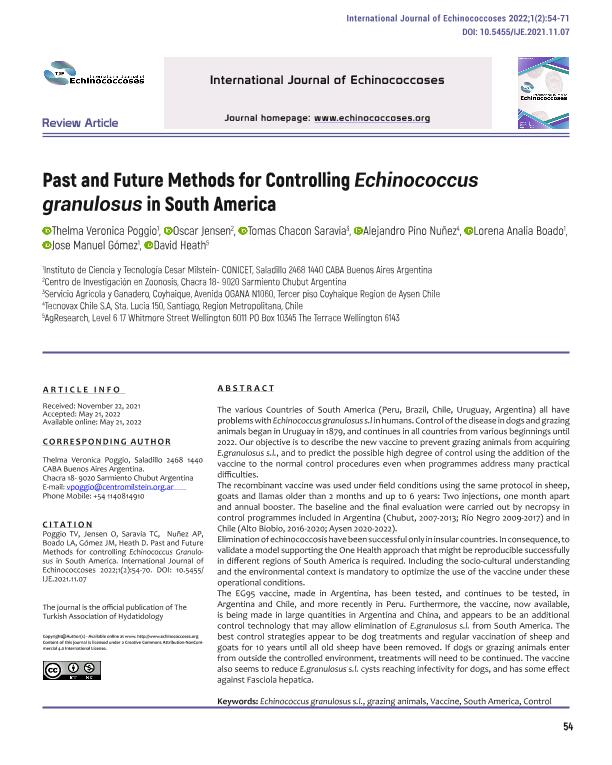Artículo
Past and Future Methods for Controlling Echinococcus Granulosus in South America
Poggio, Thelma Veronica ; Jensen, Oscar; Chacon Saravia, Tomas; Pino Nuñez, Alejandro; Boado, Lorena Analía
; Jensen, Oscar; Chacon Saravia, Tomas; Pino Nuñez, Alejandro; Boado, Lorena Analía ; Gomez, Jose Manuel
; Gomez, Jose Manuel ; Heath, David
; Heath, David
 ; Jensen, Oscar; Chacon Saravia, Tomas; Pino Nuñez, Alejandro; Boado, Lorena Analía
; Jensen, Oscar; Chacon Saravia, Tomas; Pino Nuñez, Alejandro; Boado, Lorena Analía ; Gomez, Jose Manuel
; Gomez, Jose Manuel ; Heath, David
; Heath, David
Fecha de publicación:
05/2022
Editorial:
The Turkish Association of Hydatidology
Revista:
International Journal of Echinococcoses
ISSN:
2822-3152
Idioma:
Inglés
Tipo de recurso:
Artículo publicado
Clasificación temática:
Resumen
The various Countries of South America (Peru, Brazil, Chile, Uruguay, Argentina) all haveproblems with Echinococcus granulosus s.l in humans. Control of the disease in dogs and grazinganimals began in Uruguay in 1879, and continues in all countries from various beginnings until2022. Our objective is to describe the new vaccine to prevent grazing animals from acquiringE.granulosus s.l., and to predict the possible high degree of control using the addition of thevaccine to the normal control procedures even when programmes address many practicaldifficulties.The recombinant vaccine was used under field conditions using the same protocol in sheep,goats and llamas older than 2 months and up to 6 years: Two injections, one month apartand annual booster. The baseline and the final evaluation were carried out by necropsy incontrol programmes included in Argentina (Chubut, 2007-2013; Río Negro 2009-2017) and inChile (Alto Biobio, 2016-2020; Aysen 2020-2022).Elimination of echinococcosis have been successful only in insular countries. In consequence, tovalidate a model supporting the One Health approach that might be reproducible successfullyin different regions of South America is required. Including the socio-cultural understandingand the environmental context is mandatory to optimize the use of the vaccine under theseoperational conditions.The EG95 vaccine, made in Argentina, has been tested, and continues to be tested, inArgentina and Chile, and more recently in Peru. Furthermore, the vaccine, now available,is being made in large quantities in Argentina and China, and appears to be an additionalcontrol technology that may allow elimination of E.granulosus s.l. from South America. Thebest control strategies appear to be dog treatments and regular vaccination of sheep andgoats for 10 years until all old sheep have been removed. If dogs or grazing animals enterfrom outside the controlled environment, treatments will need to be continued. The vaccinealso seems to reduce E.granulosus s.l. cysts reaching infectivity for dogs, and has some effectagainst Fasciola hepatica.
Palabras clave:
ECHINOCOCCUS GRANULOSUS
,
PROGRAMAS DE CONTROL
,
VACUNA EG95
,
OVINOS CAPRINOS
Archivos asociados
Licencia
Identificadores
Colecciones
Articulos(ICT - MILSTEIN)
Articulos de INST.DE CS. Y TECNOLOGIA "DR. CESAR MILSTEIN"
Articulos de INST.DE CS. Y TECNOLOGIA "DR. CESAR MILSTEIN"
Citación
Poggio, Thelma Veronica; Jensen, Oscar; Chacon Saravia, Tomas; Pino Nuñez, Alejandro; Boado, Lorena Analía; et al.; Past and Future Methods for Controlling Echinococcus Granulosus in South America; The Turkish Association of Hydatidology; International Journal of Echinococcoses; 1; 2; 5-2022; 26-71
Compartir
Altmétricas



